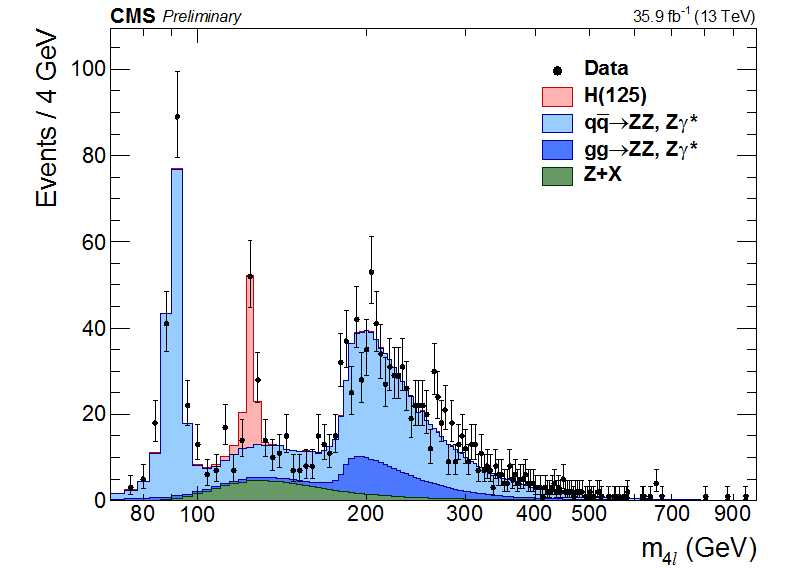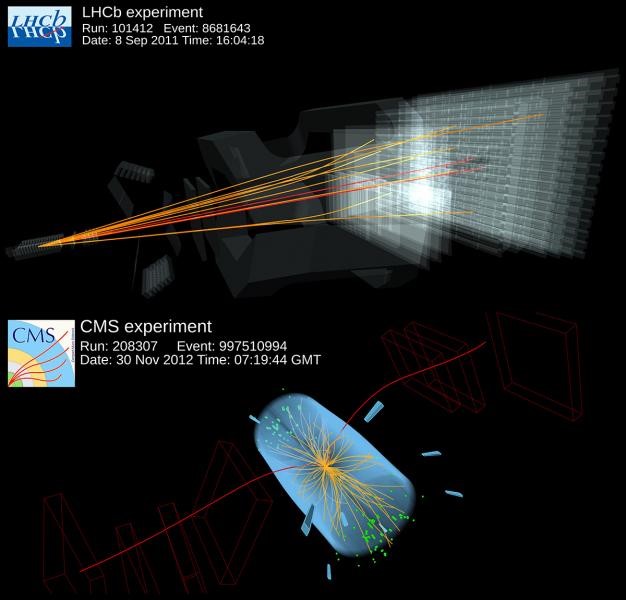A Moriond Retrospective: New Results from the LHC Experiments
Every March, particle physicists around the world take two weeks to promote results, share opinions and do a bit of skiing in-between. This is the Moriond tradition and the 52nd iteration of the conference took place this year in La Thuile, Italy. Each of the four main experiments on the LHC ring presented a variety of new and exciting results, providing an overview of the current state of the field, while shaping the discussion for future efforts.

Figure 1: Physicists taking a break from the conference proceedings. (Image credit: ATLAS-PHOTO-2017-009-3, Claire Adam Bourdarios)
Before diving into the physics of Moriond, it’s worth stepping back to note just how far the LHC has come in recent years. In 2016, a staggering amount of data was produced (around 40 fb-1 in both ATLAS and CMS), which is 60% more than expected. This is a record-breaking achievement that reflects the tireless work of physicists at every stage of the experiment. Additionally, such an integrated luminosity would not have been possible without the accelerator operators, who kept the LHC at 50% overall availability for the year [1].

Figure 2: The integrated luminosity of the LHC with proton-proton collisions in 2016 compared to previous years. Luminosity is a measure of a collider’s performance and is proportional to the number of collisions. The integrated luminosity achieved by the LHC in 2016 far surpassed expectations and is double that achieved at a lower energy in 2012. Image credit [1].
The two multipurpose LHC experiments, ATLAS and CMS, share custody of several high profile topics in high energy experiments today and Moriond offers a rare opportunity for crosstalk. For example, both collaborations are extensively involved in Higgs research, studying its characteristics and couplings to other Standard Model particles. Both experiments provided new measurements of the Higgs mass in the four-lepton decay channel that are the most precise to date [2]. In addition, CMS published direct evidence of the top-Higgs coupling that is consistent with Standard Model expectations [3], and ATLAS presented an update on its search for the Higgs in the dimuon decay channel [4]. This set of new results about the Higgs substantiates the predictions of the Standard Model, while constraining the places in which new physics could arise.

Figure 3: Distribution of the four-lepton reconstructed invariant mass m4l in the full mass range. Points with error bars represent the data and stacked histograms represented expected distribution. The SM Higgs boson signal with mH = 125 GeV and the ZZ backgrounds are normalized to the SM expectation, the Z+X background to the estimation from data. No events are observed with m4l > 1 TeV. Image credit [2].
Large strides were taken not only in Higgs physics, but in Standard Model studies as well. In one of the most noteworthy SM results, ATLAS published its first measurement of the W boson mass, using 4.6 fb-1 of 2011 data at 7 TeV. If a paper using 2011 data doesn’t exactly seem like a Moriond contemporary, consider the challenges of such an analysis at the LHC. When compared to past W mass measurements at CDF or LEP, the analyzers had to contend with a much higher number of interactions per beam crossing, as well as an increased contribution of second-generation quarks in W production. To achieve the best possible precision, ATLAS collected over 107 W to lepton plus neutrino events, an order of magnitude more data than was available for the last W mass measurement done at CDF. Such an analysis at the LHC also requires careful study of quark parton distribution functions in the proton and theoretical description of electroweak corrections. The strategy itself consists of fits to two variables: the transverse momentum of the charged lepton, and the transverse mass of the W. Given the precise measurement of the Z boson mass, Z to two lepton events are used to calibrate detector response and verify physics modelling. After combining measurements in different flavor, charge, or eta categories, the final value of the W mass, with the most precision of any measurement to date, is 80370 +- 19 MeV. This is consistent with past values (see Figure 4) and matches the pre-existing best measurement of the W mass from CDF [5].

Figure 4: The ATLAS measurement of the W boson mass is compared to the Standard Model prediction from the electroweak fit, and to the combined values measured at the LEP and Tevatron colliders. Image credit [5].
Supersymmetry (SUSY) is another subject of intense scrutiny this year. With the exclusions on squarks and gluinos climbing up to nearly 2 TeV [6] and the available phase space for the stop shrinking on every iteration [7], attention is turning to other possible search strategies. Of particular interest is electroweak SUSY, a broad category that covers decay signatures involving winos, binos, higgsinos, and sleptons. Searches in this sector are well motivated by naturalness, but very experimentally challenging; before 2017, the best limit on Higgsino masses came from LEP, a measurement that was made over ten years ago. This year, CMS stepped up to the task, coming up with several innovative strategies to reconstruct the extremely soft decay products that are characteristic of compressed Higgsino decays. With the help of new “compressed” triggers (using soft muons + MET) and discriminating variables that exploit an ISR-assisted topology, CMS was able to use muons of pT as low as 3.5 GeV. This led the collaboration to publish its first electroweak SUSY exclusion contour, excluding charginos and neutralinos of masses up to 230 GeV with a mass difference of 20 GeV at 95% confidence [8].

Figure 5: The observed exclusion contours (black) with the corresponding 1 standard deviation uncertainties. The dashed red curves present the expected limits with 1 SD experimental uncertainties. Image credit [8].
Adding to the mix, LHCb put out several important new results, the most exciting of which relate to the B meson. The first relates to lepton universality, which refers to the Standard Model prediction that the B0 will decay to final states including electron-positron or muon-anti-muon pairs in roughly equal numbers. Because of this, any data indicating a flavor preference would mean the possibility of new physics, making the LHCb observation of about 40 muon decays for every 60 electron decays all the more exciting [9]. LHCb also published a first observation of the strange B meson (containing a strange quark instead of a down quark) to two muons, a result that was seconded by CMS [10]. Both experiments have collected hints of such a decay in past years (see Figure 6), but 2016 finally provided enough data to reach the 5 sigma requirement for discovery. To cap off an already exciting set of results, LHCb also released a novel study to generate cosmic-like decays with collisions between protons and helium nuclei. Such data provides a window for the measurement of antiproton rates and as a corollary, the potential study of dark matter signals as well [11].

Figure 6: Event displays of a candidate B0S particle decaying into two muons in the LHCb detector (top - Image: LHCb/CERN) and in the CMS detector (bottom - Image: CMS/CERN). Image credit [10].

Figure 7: A fully reconstructed proton–helium collision event in the LHCb detector, with the particle identified as an antiproton shown in pink. Image credit [11].
The last LHC experiment to be discussed, ALICE, presented a variety of results on the cutting edge of heavy ion collision physics. With a new dataset consisting of proton-proton, proton-Pb, and Pb-Pb collisions, the ALICE collaboration was able to study the properties and formation of quark-gluon plasma. Specifically, QGP formation with a strangeness enhancement in heavy ion collisions is a long known effect, but it was thought that proton collisions might be too light to yield the same results. ALICE reports an increase in strangeness production from low to high multiplicity proton-proton events, alluding to the possibility of a future QGP observation in proton-proton collisions [12]. Figure 8 shows an example of such a strangeness enhancement by showing an increase in K0S meson production at higher multiplicity. The collaboration also presented new results on anisotropies and angular correlations with jets and J/psi mesons that provide new information on the interaction of these objects with the QGP medium [13]. Taken together, these results improve confidence about what is already known about QGP, while giving some hints of new physics.

Figure 8: Average pT of K0S mesons for both √s = 7 and 13 TeV data, as a function of charged particle multiplicity density. The average pT of the K mesons at 13 TeV is greater than that of the K mesons at 7 TeV for similar multiplicity densities. Image credit [12].
Now that the Moriond buzz has died down (and some much-needed holidays have been taken), the LHC community is planning its next move. There is little deadtime in the high energy physics schedule, and the summer conference season is already well underway. These upcoming meetings promise even more results that build on the ones discussed at Moriond, and such expansion will continue with the full Run 2 dataset and into the post-LS2 future of the LHC experiments.
References
- Data taking in 2016: https://home.cern/about/updates/2016/12/2016-exceptional-year-lhc
- Higgs to 4L measurement: CMS-PAS-HIG-16-041, http://atlas.web.cern.ch/Atlas/GROUPS/PHYSICS/CONFNOTES/ATLAS-CONF-2017-032/)
- CMS Top-Higgs coupling: http://cds.cern.ch/record/2256103?ln=en
- ATLAS dimuon decay: https://arxiv.org/abs/1705.04582
- ATLAS W mass physics briefing: https://atlas.cern/updates/physics-briefing/measuring-w-boson-mass
- Squark gluino limit physics briefing: http://atlas.cern/updates/physics-briefing/search-super-particles-continues
- Stop limits physics briefing: http://atlas.cern/updates/physics-briefing/hunting-superpartner-top-quark
- CMS electroweak: CMS-PAS-SUS-16-048, http://inspirehep.net/record/1518834
- Lepton universality: http://www.nature.com/news/physicists-excited-by-latest-lhc-anomaly-1.21865, http://www.symmetrymagazine.org/article/a-new-search-to-watch-from-lhcb
- B0S to dimuon: http://press.cern/press-releases/2015/05/cms-and-lhcb-experiments-reveal-new-rare-particle-decay
- Cosmics in LHCb: http://cerncourier.com/cws/article/cern/68420
- ALICE strangeness enhancement: http://moriond.in2p3.fr/QCD/2017/ThursdayAfternoon/Nayak.pdf
- ALICE anisotropy: http://moriond.in2p3.fr/QCD/2017/FridayMorning/Kofarago.pdf, http://moriond.in2p3.fr/QCD/2017/FridayMorning/Margutti.pdf
